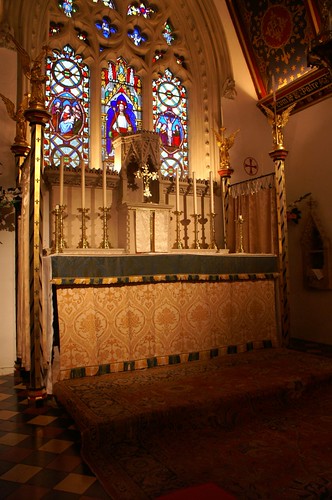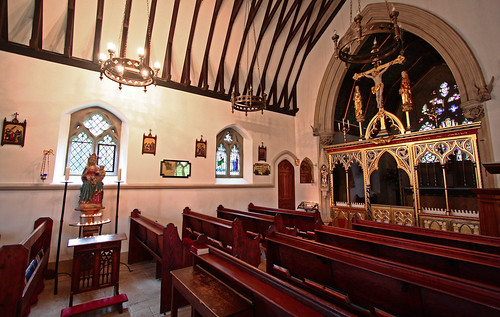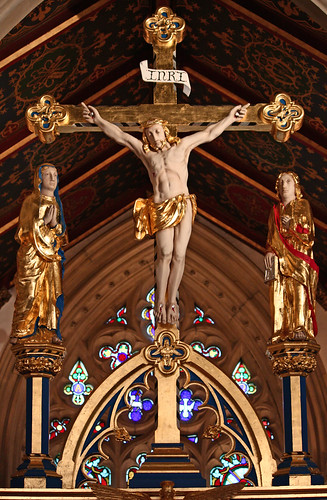Dorchester Roman Catholic Church
The tiny Roman Catholic church of St Birinus in Dorchester-on-Thames in Oxfordshire, has undergone a radical transformation over the course of the last three of four years. You might be secretly gasping in horror at the thought of the rood screen being pulled out and a destructive minimalist re-ordering, but you need not worry. Under it's parish priest Fr John Osman, a passionate enthusiast for Sir Ninian Comper, this Victorian church has had a Comperesque makeover. The church was originally built in the 1850s by architect William Wardell and the building was clearly constructed on a budget. What Fr Osman has done, arguably, is to apply the sort of decoration Wardell (a follower of Pugin) might have applied had the budget been greater.
The first part of the work saw the installation of an 'English altar', Wardell's stone reredos was retained, but the sides of the altar were newly enclosed with riddel posts and topped by four of Comper's gilded 'Nuremburg' angels.
New frontals have been acquired for the high altar and a set of Lenten Array to replace the traditional Roman violet during Lent.
When I was last in the church, work had started on transforming the rood screen, preparing it and the rood to receive rich polychromy and gilding. Looking recently at Lawrence OP's photostream on Flickr, I notice that the work on the screen has been completed and the newly decorated rood has returned to its place under the chancel arch. Houselling cloths have also been introduced at the screen, so that the faithful now receive through the openings of the screen. It all looks very glorious.


The votive images in the church have also had a bit of a spruce up and have been newly painted and gilded. The catalogue bought image of Our Lady has also been replaced with a glorious limewood copy of the fifteenth century alabaster image that is in the church at Ampleforth Abbey.
So what do people think? Is this just pastiche - a Comper theme park that breaks every single conservation principle? Is it what the church needs to serve the world today? I personally think that the result is magnificent and worth breaking conservation principle, it has a visual integrity and I look forward to seeing the work progress further. I think our spiritually moribund and over-wordy contemporary world needs more inspiring spaces like this, places that are other and can speak eloquently of the beauty and mystery of God. I know others will disagree.
You may be interested in Lawrence Lew's post over at the New Liturgical Movement.

Comments
The adaptation of the rood screen as a communion rail is ingenious. Have you seen the shot of the recently-cleaned screen at Egmanton that Andrew posted on Anglican Wanderings a few days ago?
I did see Andrew's photos on Anglican Wanderings of Egmanton, the screen is looking glorious. I was last there in 2000 before the restoration commenced and I really must return soon.
Aside from that point I can't see why something in the tradition of Pugin cannot still have resonance with the modern worshipper.